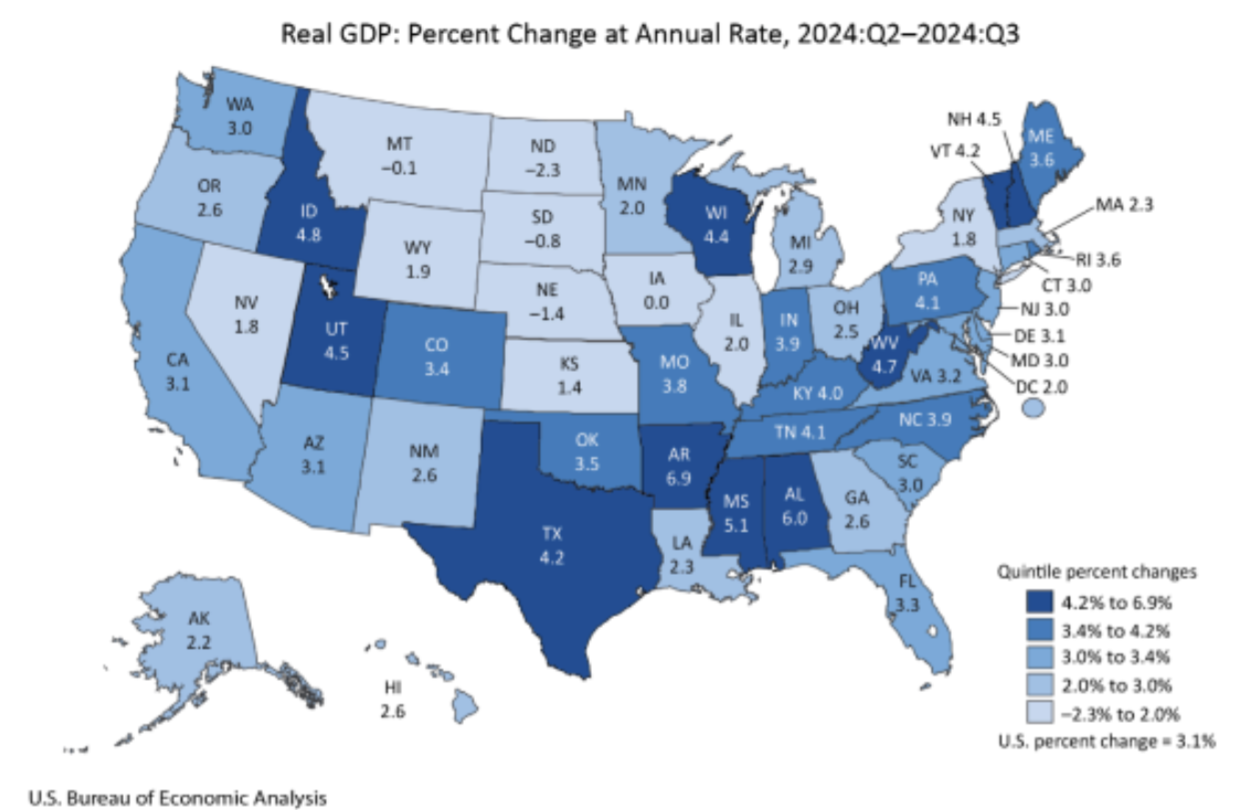New economic data paint a sobering picture for Kansas’s economy.
In Q3 2024, Kansas’s real gross domestic product (GDP) grew by just 1.4%, ranking 45th nationally. Neighboring states like Oklahoma (3.5%, Rank 19) and Colorado (3.4%, 20) significantly outperformed Kansas, reflecting stronger growth strategies, while Nebraska (-1.4%, 49) declined. These numbers demand bold reforms rooted in free-market principles to pull Kansas out of stagnation and create an economic environment where businesses and families can thrive.

What’s Holding Kansas Back?
Kansas’s GDP growth was driven by modest gains in retail trade and healthcare, but these weren’t enough to offset weaknesses in manufacturing and agriculture. Manufacturing, once a driver of Kansas’s prosperity, now struggles under the weight of regulatory barriers and rising costs. Agriculture, a cornerstone of the state’s economy, faces price volatility and global competition that magnify its cyclical nature.
Meanwhile, Kansas’s neighbors, particularly Oklahoma and Nebraska, have leveraged industries like energy and advanced manufacturing to accelerate growth. Oklahoma’s thriving energy sector and Nebraska’s focus on diversified manufacturing demonstrate what’s possible when states adopt pro-growth policies and focus on competitive advantages.
Labor Market Woes
Kansas’s struggles extend to its labor market. The unemployment rate climbed to 3.5% in November 2024, up from 2.6% a year earlier. Job growth is concentrated in low-wage industries like retail and hospitality, with limited expansion in high-wage sectors such as technology and advanced manufacturing. This imbalance stifles income mobility and leaves families with fewer opportunities to prosper.
In contrast, Oklahoma and Nebraska maintain lower unemployment rates of 3.3% and 2.8%, reflecting more robust labor markets driven by business-friendly policies. Kansas’s inability to create high-paying jobs underscores the need for reforms that reduce barriers to business growth and foster workforce development.
The Hidden Tax of Regulation
Excessive regulations are among the most significant barriers to Kansas’s economic growth, acting as a hidden tax that increases costs for businesses and consumers alike. According to the Mercatus Center, Kansas has over 72,000 individual regulatory restrictions across various industries. This places Kansas ahead of Nebraska but behind Missouri and Oklahoma, which have fewer restrictive rules. These restrictions stifle entrepreneurship, limit innovation, and discourage investment, all of which are crucial for a thriving economy.
Kansas ranks 14th nationally in economic freedom, according to the Fraser Institute, but this position hides deeper challenges. Economic freedom is driven by limited government intervention, but Kansas’s high regulatory burden and tax structure erode its competitiveness. For example, the construction sector in Kansas faces over 7,500 specific regulatory requirements, inflating costs and delaying projects. Similarly, agriculture bears the burden of over 5,000 restrictions, making it harder for farmers to adapt to market changes or implement innovative practices.
Neighboring states like Oklahoma have streamlined regulations, leading to stronger GDP growth and job creation. Sunset reviews of existing regulations in Kansas could ensure outdated policies no longer weigh on economic activity. Reducing occupational licensing requirements—among the most restrictive in the region—would also lower barriers to entry for workers and entrepreneurs, fostering greater innovation and job creation.
Free-Market Solutions for Growth
To unleash its economic potential, Kansas must adopt free-market reforms that remove barriers to growth and empower individuals and businesses.
Reducing the costs associated with Kansas’s 72,000 regulatory restrictions through targeted reviews and eliminations would open the door for businesses to expand and innovate. For instance, removing occupational licensing requirements for non-essential professions, such as certain construction or personal service roles, would immediately reduce costs and promote entrepreneurship.
Spending less and improving tax competitiveness are equally crucial. High income tax rates discourage investment and reduce disposable income for families. Lowering these rates, or even eliminating them as in one of eight states without income taxes, would attract businesses and residents alike, spurring economic growth. Reducing government spending and simplifying the tax code would also reduce compliance costs and enhance transparency.
Workforce development driven by private-sector initiatives is essential. Employer-led training programs and private scholarships in high-demand fields like technology and logistics can better align skills with market needs. These free-market solutions empower businesses to invest in their workforce without the inefficiencies of government-driven programs.
Diversifying Kansas’s economy by reducing reliance on agriculture and traditional manufacturing will also play a key role. By removing government obstacles, industries like nuclear energy, biotech, and logistics, can attract innovative businesses and create a more dynamic economic landscape.
A Brighter Future for Kansas
Kansas’s weak GDP growth and rising unemployment reveal the urgent need for reform. Neighboring states are outpacing Kansas by embracing more free-market principles that reduce government interference and empower the private sector. Reducing regulations, increasing economic freedom, spending less and lowering taxes will reinvigorate the state’s economy and ensure a brighter future for its residents.
With bold, market-driven reforms, Kansas’s economic potential can finally be realized.





